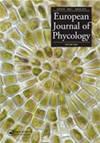印度次大陆Stauroneis Ehrenberg三新种的描述和系统发育位置
IF 1.7
4区 生物学
Q2 MARINE & FRESHWATER BIOLOGY
引用次数: 2
摘要
摘要埃伦伯格Stauroneis Ehrenberg是一个物种丰富的属,分布广泛,在截头体形态上存在一些变异。近年来,研究人员对温带地区的Stauroneis的分子多样性进行了探索,但没有热带物种的分子数据。在本研究中,利用形态学和分子数据对四种Stauroneis进行了研究。利用光学显微镜(LM)和扫描电子显微镜(SEM)分析了形态特征,并将每个分类单元的特征与属内的相似物种进行了比较。为了进行分子分析,分离、培养Stauroneis菌株,提取DNA,并分析rbcL和18S基因的序列,以确定系统发育关系。我们的分析描述了三个新物种,并记录了一个以前已知的物种。新物种有:(1)Stauroneis latetica Wadmare,Kociolek&B.Karthick,其特征是具有椭圆形披针形的瓣和短的近圆形顶端的小截头体,宽的中心蝴蝶结状的星形星形星形,少数中等条纹中心向两极强烈辐射;(2) Stauroneis sholaii Wadmare,Kociolek&B.Karthick,具有宽的披针形瓣,具有短的矩形星形花和放射状条纹;和(3)Stauroneis bartii Wadmare,Kociolek&B.Karthick,它有大的、带圆形顶端的披针形的瓣,一种有4-7条缩短条纹和辐射条纹的stauros。介绍了来自印度的先前已知的广泛分布的细纹Stauroneis gracilis Ehrenberg的超微结构和分子数据。形态学和分子生物学相结合的方法支持将S.红土、S.sholaii和S.bartii识别为新种。这项研究是首次尝试在印度次大陆发现硅藻的分子物种。本文章由计算机程序翻译,如有差异,请以英文原文为准。
Description and phylogenetic position of three new species of Stauroneis Ehrenberg (Bacillariophyceae: Stauroneidaceae) from the Indian Subcontinent
ABSTRACT Stauroneis Ehrenberg is a species-rich genus that is common and widespread with some variation in frustule morphology. Recently, studies have explored the molecular diversity of the Stauroneis from the temperate region, but there are no molecular data for tropical species. In the present study, four species of Stauroneis were investigated using morphological and molecular data. Morphological characters were analysed using light microscopy (LM) and scanning electron microscopy (SEM), and the features of each taxon were compared with similar species within the genus. For the molecular analyses, Stauroneis strains were isolated, cultured, DNA was extracted, and sequences from rbcL and 18S genes were analysed to determine phylogenetic relationships. Our analysis describes three new species and records one previously known species. The new species are: (1) Stauroneis lateritica Wadmare, Kociolek & B.Karthick, characterized by small frustules with elliptical lanceolate valves and short subrostrate apices, broad central bow-tie shaped stauros, and few moderate striae centrally becoming strongly radiate towards the poles; (2) Stauroneis sholaii Wadmare, Kociolek & B.Karthick, which has broad lanceolate valves with short rectangular stauros and radiate striae; and (3) Stauroneis bartii Wadmare, Kociolek & B.Karthick, which has large, lanceolate valves with rounded apices, a stauros with 4–7 shortened striae and radiate striae. Ultrastructure and molecular data from India for the previously known, widespread species Stauroneis gracilis Ehrenberg are presented. The combined morphological and molecular approach supports recognition of S. lateritica, S. sholaii and S. bartii as new species. This study is the first-ever attempt at molecular species discovery of diatoms from the Indian subcontinent.
求助全文
通过发布文献求助,成功后即可免费获取论文全文。
去求助
来源期刊

European Journal of Phycology
生物-海洋与淡水生物学
CiteScore
4.80
自引率
4.20%
发文量
37
审稿时长
>12 weeks
期刊介绍:
The European Journal of Phycology is an important focus for the activities of algal researchers all over the world. The Editors-in-Chief are assisted by an international team of Associate Editors who are experts in the following fields: macroalgal ecology, microalgal ecology, physiology and biochemistry, cell biology, molecular biology, macroalgal and microalgal systematics, applied phycology and biotechnology. The European Journal of Phycology publishes papers on all aspects of algae, including cyanobacteria. Articles may be in the form of primary research papers and reviews of topical subjects.
The journal publishes high quality research and is well cited, with a consistently good Impact Factor.
 求助内容:
求助内容: 应助结果提醒方式:
应助结果提醒方式:


